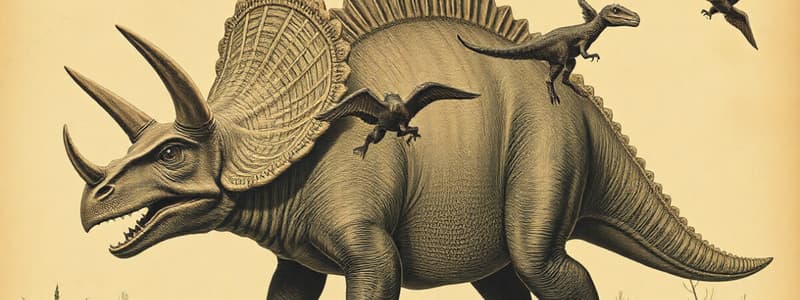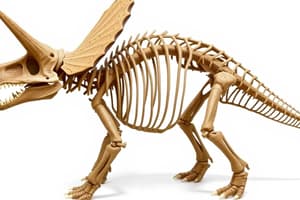Podcast
Questions and Answers
What was a primary function of the horns and frill of Triceratops?
What was a primary function of the horns and frill of Triceratops?
- For hunting prey
- For display, defense, and intraspecies combat (correct)
- For locomotion
- For temperature regulation
Which type of diet did Triceratops primarily follow?
Which type of diet did Triceratops primarily follow?
- Detritivorous
- Carnivorous
- Omnivorous
- Herbivorous (correct)
What was the estimated height range of Triceratops?
What was the estimated height range of Triceratops?
- 3 meters (10 feet) (correct)
- 5-7 meters (16-23 feet)
- 2-4 meters (6.5-13 feet)
- 1-3 meters (3-10 feet)
Where have Triceratops fossils been primarily found?
Where have Triceratops fossils been primarily found?
What was significant about the arrangement of Triceratops's teeth?
What was significant about the arrangement of Triceratops's teeth?
What does the robust build of Triceratops suggest about its lifestyle?
What does the robust build of Triceratops suggest about its lifestyle?
What does the classification of Triceratops within Ceratopsia imply?
What does the classification of Triceratops within Ceratopsia imply?
What evidence suggests that Triceratops may have lived in groups?
What evidence suggests that Triceratops may have lived in groups?
What does the name Triceratops mean?
What does the name Triceratops mean?
What was the primary habitat of Triceratops during the late Cretaceous Period?
What was the primary habitat of Triceratops during the late Cretaceous Period?
How heavy could a Triceratops potentially get?
How heavy could a Triceratops potentially get?
What feature of the Triceratops' skull was significant in terms of size?
What feature of the Triceratops' skull was significant in terms of size?
What evolutionary purpose might the headplate of Triceratops serve?
What evolutionary purpose might the headplate of Triceratops serve?
Flashcards
What was a key physical characteristic of Triceratops?
What was a key physical characteristic of Triceratops?
Triceratops possessed a distinctive large bony frill extending from the back of its head. The shape and ornamentation of the frill varied.
How were Triceratops horns used?
How were Triceratops horns used?
They had two prominent horns above their eyes, typically longer than the single horn on their nose. These horns and the frill were likely used for display, defense, and/or intraspecies combat.
What type of diet did Triceratops have?
What type of diet did Triceratops have?
Triceratops was a herbivore. Its specialized beak-like mouth and numerous teeth were well-adapted for cropping vegetation. The teeth were arranged in dental batteries, optimized for efficiently grinding plant material.
What kind of plants did Triceratops eat?
What kind of plants did Triceratops eat?
Signup and view all the flashcards
How large was Triceratops?
How large was Triceratops?
Signup and view all the flashcards
Where have Triceratops fossils been found?
Where have Triceratops fossils been found?
Signup and view all the flashcards
What group of dinosaurs does Triceratops belong to?
What group of dinosaurs does Triceratops belong to?
Signup and view all the flashcards
How did Triceratops likely live?
How did Triceratops likely live?
Signup and view all the flashcards
What was the Triceratops?
What was the Triceratops?
Signup and view all the flashcards
How big was the Triceratops?
How big was the Triceratops?
Signup and view all the flashcards
What were the Triceratops' horns used for?
What were the Triceratops' horns used for?
Signup and view all the flashcards
What was the function of the Triceratops' frill?
What was the function of the Triceratops' frill?
Signup and view all the flashcards
What was a predator of the Triceratops?
What was a predator of the Triceratops?
Signup and view all the flashcards
Study Notes
Physical Characteristics
- Triceratops possessed a large bony frill extending from the back of its head, varying in shape and ornamentation.
- It had two prominent horns above its eyes, typically longer than the single horn on its nose.
- The horns and frill likely served for display, defense, and/or intraspecies combat.
- Triceratops had a relatively short, robust neck and a massive, bony structure framing its skull, forming a frill.
- Its overall body shape was quadrupedal, with powerful legs supporting its movement.
- A thick, robust build indicated a heavy animal capable of withstanding impact.
- The skull could account for almost one-third of the animal's total body length, with the largest discovered skull measuring an estimated 8.2 feet in length.
Diet and Feeding Behavior
- Triceratops was a herbivore, grazing on leaves and grass.
- Its specialized beak-like mouth and numerous teeth, arranged in dental batteries, were well-adapted for cropping vegetation efficiently.
- It probably consumed tough plants like ferns, cycads, and conifers.
- It likely grazed and browsed low-lying vegetation and possibly higher plant types.
- The shape and arrangement of teeth indicated a strong bite force for processing vegetation.
Size and Distribution
- Triceratops was a large animal, reaching lengths of 7-9 meters (23-29 feet) and approximately 3 meters (10 feet) in height, weighing up to 12 tons.
- This size is similar to an African elephant.
- Fossils of Triceratops have been found in North America, specifically in Late Cretaceous rock formations, suggesting a relatively wide geographic range during its time.
- Triceratops inhabited the fields and forests of what is now North America, around 67 to 65 million years ago.
Discovery and Classification
- The first fossils were tentatively identified in the late 19th century, with detailed descriptions and specimens discovered in the western United States.
- Initially, the horns were mistaken for giant bison bones.
- Triceratops is classified within the Ornithischia, specifically the Ceratopsia group of horned dinosaurs.
- Several species of Triceratops are recognized by paleontologists, with variations in frill morphology and horn sizes potentially indicating distinct species.
Paleobiology (Behavior and Lifestyle)
- Triceratops likely lived in herds, evidenced by the close proximity of numerous specimens in fossil discoveries.
- Its large size, horns, and frill were essential for defense against predators like Tyrannosaurus Rex.
- The frill's function could involve protection from biting predators and use in intraspecies sparring or competition. It possibly acted as a radiator for body temperature regulation.
- It likely used its beak and teeth for stripping plants, rather than chewing like mammals.
- Triceratops was relatively slow-moving but suited to grazing.
- They played a crucial role in the Late Cretaceous ecosystem as major herbivores. Fossils show bite and chew marks matching T-Rex teeth.
- The two brow horns twisted and elongated with age.
Studying That Suits You
Use AI to generate personalized quizzes and flashcards to suit your learning preferences.
Description
This quiz explores the unique physical traits and dietary habits of the Triceratops. Discover its distinctive frill, horns, and specialized herbivorous feeding adaptations. Test your knowledge on this iconic dinosaur's characteristics and feeding behavior.

